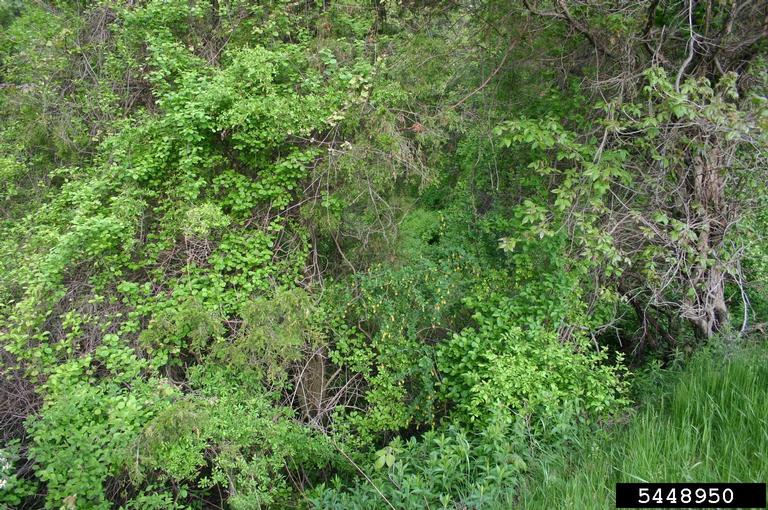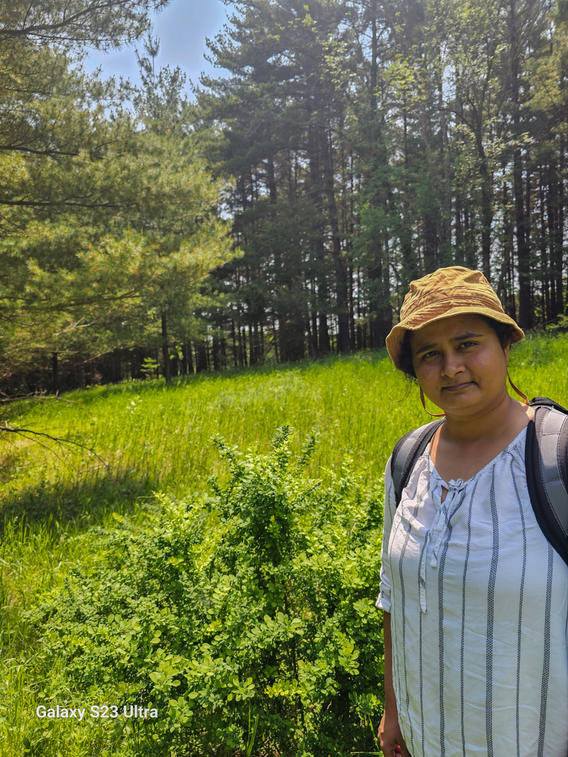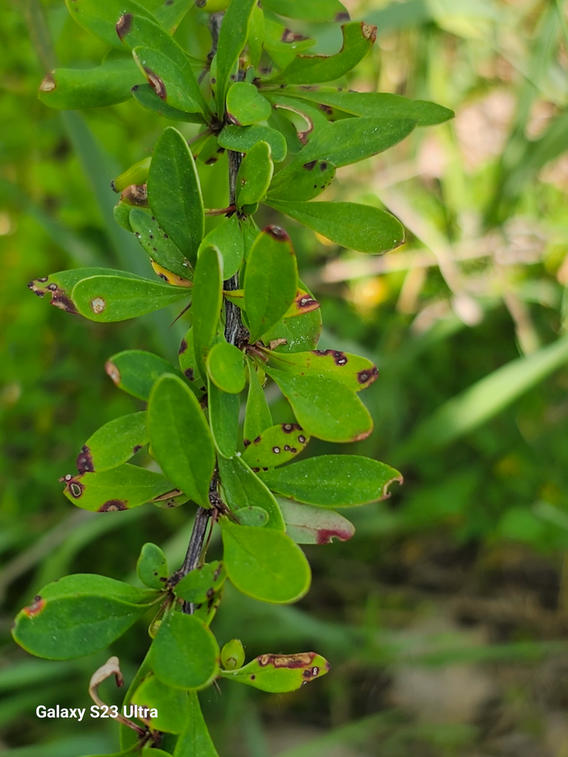by Carolyn Bernhardt
January 16, 2024
Amidst Minnesota’s dense forests and sprawling landscapes, hybrids between the invasive species of common barberry (Berberis vulgaris) and Japanese barberry (Berberis thunbergii) have taken root. Hybrid barberry (Berberis × ottawensis) has long dodged research efforts. It is notorious for not only spreading voraciously, but also for catalyzing rust diseases devastating to wheat and small grain crops.

“Hybrid barberry and their parental species are highly invasive [and] reproduce rapidly, forming vast thickets in forested habitats,” says Pablo D. Olivera Firpo, PhD, a research associate professor in the Department of Plant Pathology at the College of Food, Agricultural and Natural Resource Sciences. He recently led a project to conduct the first-ever comprehensive survey of hybrid barberry’s presence in Minnesota. “These dense stands formed in the understory displace native species and inhibit forest regeneration.”
Unfortunately, accurate identification of this hybrid poses a few challenges. When two invasive species hybridize, hybrids can resemble their parents, necessitating DNA markers for identification. Additionally, suspected hybrid barberry plants in Minnesota exhibit diverse physical traits, which makes visual identification even more difficult. "As phenotypic traits can mislead species identification, molecular tools are increasingly valuable," Olivera Firpo says. But an affordable, universally accessible tool for labs has yet to be developed—until now.
Olivera Firpo and a team of collaborators used funding from the Minnesota Invasive Terrestrial Pests and Plants Center (MITPPC) to develop a genetic test to confirm the identity of a barberry plant to help determine the distribution of hybrid barberry, its susceptibility to stem rust, and its threat to small grain producers.
Parsing problematic plants
Olivera Firpo notes that these hybrids possess traits of wider adaptability and varying susceptibility to wheat rust, raising concerns about their impact on rust spread. "Raising awareness about both hybrid barberry and its parental species is crucial," he says.
The research team checked places where regular barberry and Japanese barberry grow, using reports to guide them. Olivera Firpo says, “Our approach was to conduct a targeted survey across the state of Minnesota where the parental species—common barberry and Japanese barberry—and putative hybrids were reported.” Jyoti Sharma, PhD, a postdoctoral researcher in Olivera Firpo’s lab, led this work.

Sharma, Olivera Firpo, and team looked at traits like leaf size and margin serration, spines, and rust infections in 430 plants from about 40 spots in 2021 and 2022. Of those, 115 looked like hybrids, so the team lab tested them for stem rust resistance in controlled conditions. The researchers used DNA markers to make a tool that finds hybrid barberry plants. Starting from 460 markers found in New England, they made 120 cost-effective markers. After tests, 33 markers worked well to spot hybrids in Minnesota, establishing a method that helps labs identify hybrid barberries easily.

At Afton State Park, the researchers noticed some plants showed rust infection, ranging from spots to aecia (the fruiting body of certain rust fungi) with spores. “After conducting DNA studies, we confirmed the presence of Poa stripe rust,” says Olivera Firpo. “This result confirms the presence of hybrids susceptible to stripe rust.” In controlled tests for stem rust reaction, some plants had necrotic spots but no spores, unlike healthy Japanese barberry, which is completely immune. More tests are needed to confirm if these plants are fully vulnerable hybrids.
Common barberry stuck around after the national Barberry Eradication Program ended. Olivera Firpo says that with Japanese barberries spreading quickly in natural areas, both might grow together, creating a perfect setup for hybrids to establish. As these hybrids show up more, accurately identifying and locating them becomes even more vital.
Critical insights and key collaborations
“Detailed knowledge of invasive plant species, including information on their distribution and abundance, dispersal mechanisms, and predictions of impacts of invasion, are all essential for developing and prioritizing management efforts, which require long-term planning and significant investment,” says Olivera Firpo.
Such accurate identification methods could help sway regulations concerning these species in Minnesota, as well as at a national level. This research also raises awareness among Minnesota land managers and cereal crop growers, highlighting the importance of attention to these species.

“One of the project's strengths is the comprehensive survey of hybrids and parental species conducted in Minnesota that allows us to have an excellent representation of each species across the state,” says Olivera Firpo. “This was possible thanks to the support of our network of collaborators that facilitated access to many locations that we would otherwise not be able to reach.”
This project involved the University of Minnesota's Department of Plant Pathology, the USDA-ARS Cereal Disease Lab (CDL), the Minnesota Department of Agriculture (MDA), and the University of New Hampshire. “Our lab team led the research counting with the expertise and support of the CDL to conduct the rust evaluations of putative hybrids in controlled conditions,” Olivera Firpo says. The MDA connected the researchers with local experts on invasive species, helping them find and study barberry sites. The University of New Hampshire provided a crucial hybrid population for testing the markers we developed before using them in Minnesota.
New trajectories
Even though the scientists checked many maybe-hybrid plants for rust in controlled conditions, Olivera Firpo says researchers need to conduct more testing to better determine rust vulnerability. Also, creating more genomic tools for other barberry types will make it easier to spot hybrids accurately.
“Our research proved that the DNA markers developed in our lab from an original study conducted in a population on the East Coast were also effective in identifying hybrids in Minnesota,” says Olivera Firpo. “The next step that our lab wants to take is to bring these approaches to a national level and prove if these markers can be diagnostic of the hybrid populations that occur across the country.”
Now, the lab is teaming up with Dr. Yue Jin’s lab at the USDA-ARS Cereal Disease Lab for nationwide research. The team aims to study how these plants affect rust diseases differently. They will watch rust on hybrid barberries, check if they're prone to rust, and examine the rust itself in greater detail. “We are also considering using this approach to study the potential occurrence of hybrid buckthorn in Minnesota,” says Olivera Firpo.
Olivera Firpo highlights MITTPC’s support: “Not only for providing the funds for this research but also for the continuing support during the length of this project, always making sure that everything runs smoothly,” he says. “Great people to work with.”
The Minnesota Invasive Terrestrial Plants and Pests Center is supported by the Environment and Natural Resources Trust Fund, as recommended by the Legislative-Citizen Commission for Minnesota Resources.
Stay connected by signing up for the MITPPC newsletter. Follow us on LinkedIn and Facebook.
You may also like...
- Detecting hybrid barberry and investigating its role in rust epidemiology, research project
- Seminar recording by Jyoti Sharma, PhD, "Detecting hybrid barberry and investigating its role in rust epidemiology" (video ~32 minutes)
- Japanese barberry information, MN Department of Natural Resources
- Common barberry information, MN Department of Agriculture
- Japanese barberry information, MN Department of Agriculture